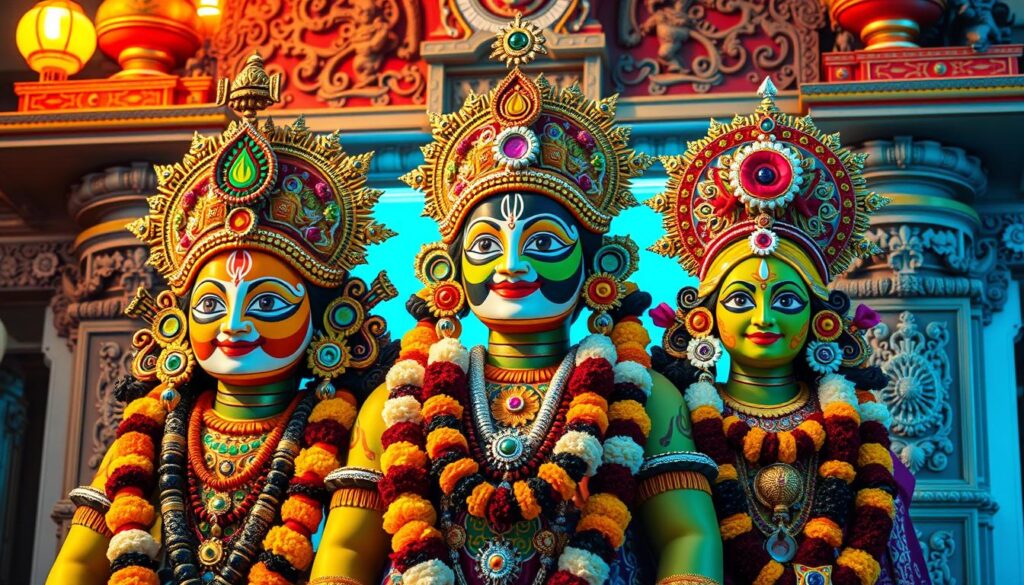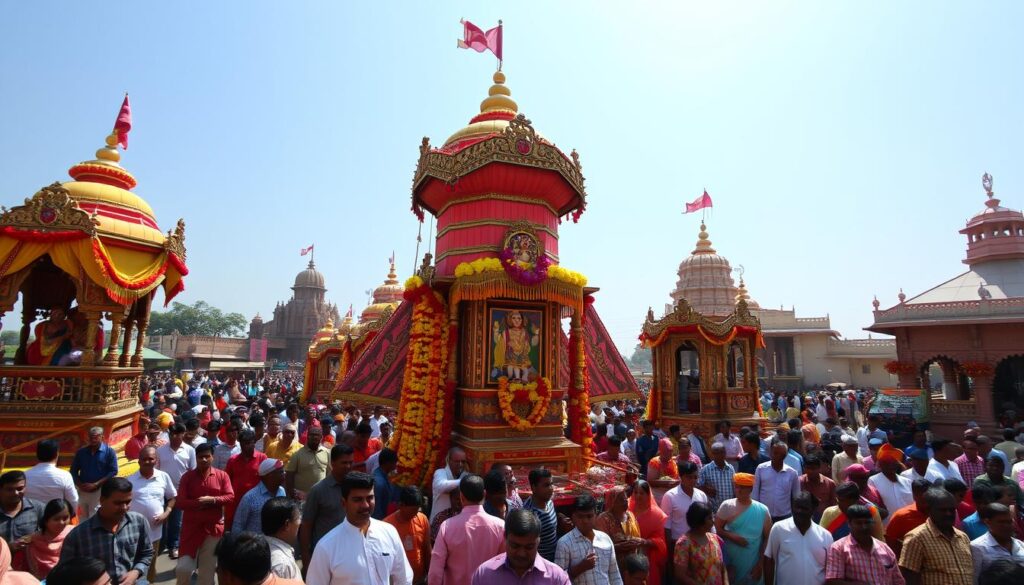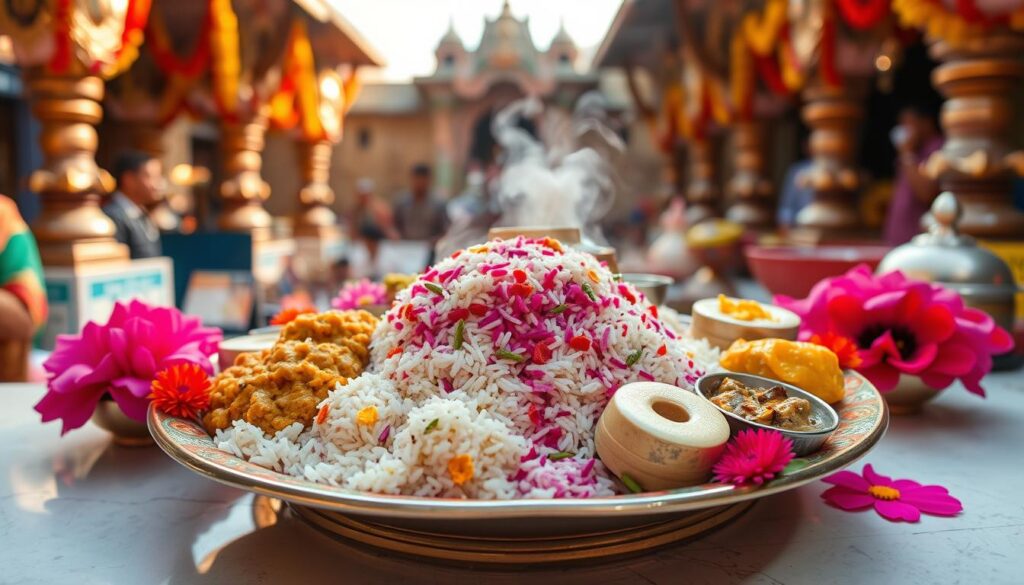The Jagannatha Temple in Puri, Odisha, is a sacred Hindu site. It’s known for its deep cultural and religious importance in India. The temple is dedicated to Lord Jagannatha and his family, including Balabhadra and Subhadra.
Other important figures like Sudarshana, Madhaba, Sridevi, and Bhudevi are also worshipped here. The temple’s rituals are divided into three main types. These include daily, periodical, and festive rituals, showing the temple’s detailed ceremonial practices.
The Shri Jagannath Temple employs over a thousand people in its rituals. Every day, five food offerings are made to the deities. The temple’s Mahaprasada, or food, includes 56 different dishes all year round.
During festivals, special dishes are added. This shows the temple’s commitment to offering the best to its deities.
The temple’s daily rituals start at 4:30 am and go until midnight. Each ritual is a step towards the next, showing deep devotion. This highlights the temple’s strong sense of reverence.
An Introduction to Jagannatha Temple
The Jagannatha Temple is in Puri, Odisha. It’s a key spiritual spot and one of the four main pilgrimage sites in Hinduism. This temple is for Lord Jagannath, an avatar of Vishnu. It’s famous for its Ratha Yatra (Chariot Festival), drawing people from all over.
Historical Significance of the Temple
The Jagannatha Temple started in the 12th century with King Anantavarman Chodaganga’s help. Over time, it grew and changed under the Ganga and Gajapati dynasties. It’s filled with legends and traditions, with Jagannath carved from sacred neem wood.
Architectural Style and Features
The Jagannatha Temple is a wonder of Kalinga architecture, reaching 65.47 meters high. Its Pancharatha style, with a central spire and four others, is unique. The complex also has the Aruna Stambh, Mukti Mandapa, and Rohini Kunda, adding to its beauty and importance.
The temple’s history, design, and role in the Puri Rath Yatra make it a key stop. It’s a Spiritual Journey to Puri and a must-see for those interested in Jagannath Temple Architecture.
The Deities of Jagannatha Temple

At the heart of the Jagannatha Temple in Puri lies the captivating presence of the main deities – Jagannath, Subhadra, and Balabhadra. These sacred wooden figures, carved from neem logs, are the focal point of the temple’s rituals and spiritual significance. Accompanying the trio are the equally revered sub-deities of Sudarshana Chakra, Madanmohan, Sridevi, and Vishwadhatri, each with its own symbolic importance.
Lord Jagannatha – The Main Deity
The striking appearance of Lord Jagannath, with his distinct large eyes and irregular limbs, is a testament to the Cosmic Dance of the Divine. This unique form is believed to represent the Jagannatha Temple and Its Rituals, embodying the very essence of the temple’s spiritual heritage. Devotees are captivated by the Cosmic Dance of Lord Jagannath, finding profound meaning in the Symbolic Significance of Jagannath Deities.
Sub-Deities Worshipped at the Temple
- Subhadra, the sister of Lord Jagannath, symbolizes the feminine divine energy.
- Balabhadra, the elder brother, represents the protective and nurturing aspect of the divine.
- Sudarshana Chakra, the divine discus, is revered as the all-powerful weapon of Lord Vishnu.
- Madanmohan, Sridevi, and Vishwadhatri are additional deities whose worship is intricately woven into the temple’s rituals and traditions.
The origins of these deities predate the temple’s construction, with evidence suggesting they may have evolved from an ancient tribal shrine. The oldest known textual reference to the Jagannath deities can be found in the Oddiyana Vajrayāna Tantric text Jñānasiddhi by Indrabhuti, further highlighting the temple’s deep-rooted spiritual legacy.
Annual Ratha Yatra (Chariot Festival)

The Puri Rath Yatra, also known as the Chariot Festival, is a big deal in Odisha. It’s a major celebration of the Sacred Rituals of Lord Jagannath. This event is very important for those who follow the Lord Jagannath worldwide.
Significance of the Ratha Yatra
The Ratha Yatra remembers the journey of three main deities. They are Lord Jagannath, Lord Balabhadra, and Devi Subhadra. They go from the Jagannath Temple to the Gundicha Temple, about two miles away.
This procession has been happening since the 12th century. It shows the deep desire of devotees to be with the Lord.
Rituals and Events During the Festival
The Odisha Festivals and Celebrations before the Ratha Yatra are full of tradition. Two weeks before, the deities have a big public bath called Snana Yatra. Then, they are hidden for fifteen days before the big procession.
During the Ratha Yatra, thousands of people help push the chariots. Each chariot is for a different deity. This festival draws millions of pilgrims, showing its cultural and spiritual value.
Daily Rituals at Jagannatha Temple

The Jagannatha Temple in Puri, Odisha, is known for its sacred rituals. These rituals happen from dawn to night. They honor Lord Jagannath and his consorts with great devotion.
Mangal Arati – The Morning Ritual
The day starts with the Mangal Arati at dawn. At 5 a.m., the temple opens. Five Sevayats light lamps and chant mantras.
Bhoga – Offerings to the Deity
Throughout the day, the temple has Bhoga rituals. These include the Gopala Ballava Bhoga at 9 a.m. and the Sakala Dhupa at 10 a.m. The day ends with the Badasinghar Bhoga at 11 p.m.
The Sacred Rituals of Lord Jagannath at the Hindu Temple Traditions in Puri are a deep Spiritual Journey. They attract devotees from everywhere, showing the temple’s timeless traditions.
Special Festivals Celebrated at the Temple

The Jagannatha Temple in Puri, Odisha, is a center of spiritual and cultural events all year. Two big festivals are the Nabakalebara and the Snana Yatra.
Nabakalebara – The Changing of Idols
The Nabakalebara festival happens every 12 or 19 years. It’s when the wooden idols of the deities are changed. This event shows the cycle of life and the renewal of the divine.
The Nabakalebara festival is a key part of Odisha’s Festivals and Celebrations. It shows the deep connection to the Jagannatha Temple and Its Rituals.
Snana Yatra – The Bathing Ceremony
The Snana Yatra, or the annual bathing ceremony, is another big festival. It happens on the full moon day of the Jyeshtha month. The deities are bathed with 108 pitchers of water from a well near the Northern Gate.
The Snana Yatra is a key ritual. It shows the importance of Odisha Festivals and Celebrations. It’s a big part of the Jagannatha Temple and Its Rituals.
Other important events at the Jagannatha Temple include the Chandan Yatra, Deba dipabali, and various pujas. These happen on special days like Ekadasi, Sankranti, and Amabasya. Each festival and ritual adds to the rich culture of Odisha’s Festivals and Celebrations.
Pilgrimage and Visitors
The Jagannatha Temple in Puri, Odisha, India, is famous among Hindus, especially Vaishnavites. Built in the 12th century, it’s linked to saints like Ramanujacharya, Madhvacharya, and Chaitanya Mahaprabhu. This makes it a key spot in many people’s spiritual paths.
Visitors can dive into the temple’s rituals and see its stunning architecture. Puri has many places to stay and things to do. It welcomes millions of pilgrims and tourists each year.
The Journey to Puri
Going on a spiritual journey to Puri changes many people. The temple’s Hindu temple traditions and Jagannatha Temple and its rituals attract visitors worldwide. They come to feel closer to the divine and join in the temple’s ancient customs.
Visitor Experience and Accommodations
When you get to the temple, you’ll feel the special atmosphere. You can join in the rituals and ceremonies. Puri has many places to stay, from cheap to fancy, to meet everyone’s needs.
Seeing the Ratha Yatra (Chariot Festival) or making sacred offerings is unforgettable. The Jagannatha Temple in Puri offers a deep spiritual journey. It connects visitors to Hinduism’s timeless traditions.
The Role of the Mahaprasad

At the heart of the Sacred Rituals of Lord Jagannath is the Mahaprasad. It’s the food offered to the deities in the Hindu Temple Traditions of Puri. This special food, made with great care and respect, is key to the Spiritual Journey to Puri.
What is Mahaprasad?
Mahaprasad, or Abhada, is the food given to Lord Jagannath and His siblings, Balabhadra and Subhadra, at the Jagannath Temple in Puri. It’s made from 56 different dishes in the temple’s kitchen, the Rosasala. These dishes are made using old methods and ingredients.
Spiritual Importance of Mahaprasad
The Mahaprasad is seen as blessed by Lord Jagannath. Eating this food is a deep spiritual act. It’s believed to clean the mind, body, and soul of those who eat it.
Stories and texts say eating Mahaprasad brings divine grace, spiritual light, and a spot in heaven. The Mahaprasad’s making and sharing follow strict rules. This shows the value of equality, respect, and the sacredness of the offering.
Thousands of people, from all walks of life, eat the Mahaprasad every day at the Ananda Bazar in the temple. This shows the tradition’s welcoming nature.
The Mahaprasad’s role in the Hindu Temple Traditions of Jagannath Temple is deep. It feeds both the body and soul. The Sacred Rituals of Lord Jagannath and the Spiritual Journey to Puri are closely linked to this special food.
Cultural Impact of Jagannatha Temple
The Jagannatha Temple in Odisha has deeply shaped the area’s culture and society. Its special rituals, festivals, and traditions have greatly influenced local art, music, and writing. The temple’s mix of different cultural influences shows a rich and varied heritage.
Influence on Local Traditions
The Jagannatha cult is a big part of Odisha’s culture. The temple’s practices, like the Rath Yatra (Chariot Festival), have inspired local artists. They create colorful paintings, sculptures, and textiles that show the “Cosmic Dance of Lord Jagannath.” Odisha Festivals and Celebrations around the Jagannatha Temple have also led to unique music and theater. This has made the region’s culture even stronger.
Jagannatha’s Global Recognition
The Jagannatha cult is known all over the world. Devotees and scholars from everywhere study and join in its traditions. Jagannatha Temple and Its Rituals stand for religious tolerance, community harmony, and global unity. People from all walks of life come to see the grand Rath Yatra and feel the temple’s spiritual power.
The Jagannatha Temple’s lasting effect on Odisha’s culture and its growing fame worldwide show the deep impact of Jagannatha’s Cosmic Dance on the area and beyond.
Conclusion: The Enduring Legacy of Jagannatha Temple
The Jagannatha Temple in Puri, Odisha, shows the lasting power of Hindu faith and culture. This sacred place has a history going back to the 12th century. It draws millions of people from all over the world.
Its rituals and traditions have been kept alive for centuries. They connect ancient spiritual practices with today’s beliefs.
Importance in Modern Times
The Jagannatha Temple’s legacy shows its big impact on India’s spiritual and cultural scene. Even after many years, its rituals like the Nabakalebara ceremony and Rath Yatra still bring in huge crowds. This shows the temple’s key role in Hindu worship.
The temple’s design and history are also important. The Archaeological Survey of India (ASI) helps protect them. This helps scholars and researchers learn more about India’s rich culture.
Continued Relevance of Its Rituals
The Jagannatha Temple’s rituals are still important today. The Rath Yatra, or Chariot Festival, is a big event that millions attend. It shows the temple’s rituals are still powerful.
The Nabakalebara ceremony, where new idols are made, also fascinates many. It shows the temple’s ability to keep its spiritual importance alive. These rituals remind us of the connection between the divine and us, inspiring faith and devotion.

